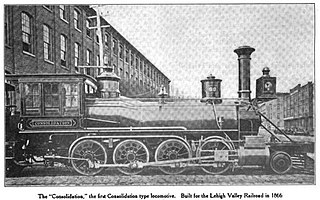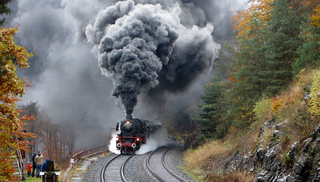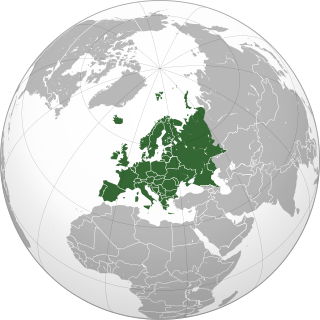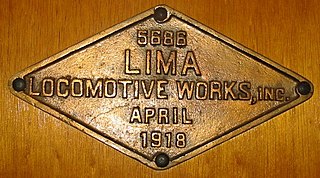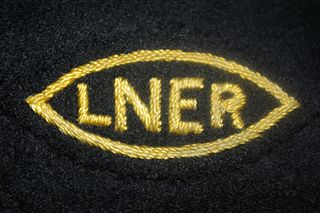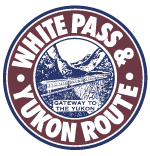
The White Pass and Yukon Route is a Canadian and U.S. Class II 3 ft narrow-gauge railroad linking the port of Skagway, Alaska, with Whitehorse, the capital of Yukon. An isolated system, it has no direct connection to any other railroad. Equipment, freight and passengers are ferried by ship through the Port of Skagway, and via road through a few of the stops along its route.

The American Locomotive Company, often shortened to ALCO, ALCo or Alco, designed, built and sold steam locomotives, diesel-electric locomotives, diesel engines and generators, specialized forgings, high quality steel, armed tanks and automobiles and produced nuclear energy. The American Locomotive Company was formed in 1901 by the merger of Schenectady Locomotive Engine Manufactory of Schenectady, New York, with seven smaller locomotive manufacturers.
Under the Whyte notation for the classification of steam locomotives, 2-10-0 represents the wheel arrangement of two leading wheels on one axle, ten powered and coupled driving wheels on five axles, and no trailing wheels. This arrangement was often named Decapod, especially in the United States, although this name was sometimes applied to locomotives of 0-10-0 "Ten-Coupled" arrangement, particularly in the United Kingdom. Notable German locomotives of this type include the war locomotives of Class 52.

Under the Whyte notation for the classification of steam locomotives by wheel arrangement, 4-6-0 represents the configuration of four leading wheels on two axles in a leading bogie, six powered and coupled driving wheels on three axles and no trailing wheels. In the mid 19th century, this wheel arrangement became the second most popular configuration for new steam locomotives in the United States of America, where this type is commonly referred to as a Ten-wheeler.As a locomotive pulling trains of lightweight all wood passenger cars in the 1890-1920s, it was exceptionally stable at near 100 mph speeds on the New York Central's New York to Chicago Water Level Route and on the Reading Railroad's Camden to Atlantic City, NJ, line. As passenger equipment grew heavier with all steel construction, heavier locomotives replaced the Ten Wheeler.

Under the Whyte notation for the classification of steam locomotives, 0-8-0 represents the wheel arrangement of no leading wheels, eight powered and coupled driving wheels on four axles and no trailing wheels. Locomotives of this type are also referred to as eight coupled.

Under the Whyte notation for the classification of steam locomotives by wheel arrangement, 4-10-2 represents the arrangement of four leading wheels, ten powered and coupled driving wheels and two trailing wheels. In South Africa, where the wheel arrangement was first used, the type was known as a Reid Tenwheeler. In the United States of America it was known as a Southern Pacific on the Southern Pacific Railroad and as an Overland on the Union Pacific Railroad.

The United States Army Transportation Corps (USATC) S118 Class is a class of 2-8-2 steam locomotive. Built to either 3 ft, 1,000 mmmetre gauge or 3 ft 6 in gauge, they were used in at least 24 different countries across the World.
The Turkish Republic Railways (TCDD) 46201 Class is a class of ex-USATC Lend-Lease S200 Class 2-8-2 steam locomotives.

The EMD MRS-1 is a type of road switcher diesel-electric locomotive built by General Motors Electro-Motive Division for the United States Army Transportation Corps (USATC) in 1952. They were built with multigauge trucks and to a narrow loading gauge for service anywhere in the world in the event of war. Thirteen of the locomotives were built, with serial numbers 15873–15885. At almost $500,000 each in 1952 dollars, more than three times the price of a standard locomotive of the period, these were very expensive locomotives.
Ferrocarril de Langreo or FC de Langreo (FCL) was a Spanish railway company which operated a 1,435 mmstandard gauge line, in the Autonomous Community of Asturias, in northern Spain. It was the third train line constructed in Spain and was built during the 1850s.

The Alco MRS-1 is a type of diesel-electric locomotive built by the American Locomotive Company for the United States Army Transportation Corps. They were built with multigauge trucks and to a reduced loading gauge for service anywhere in the world in the event of war.
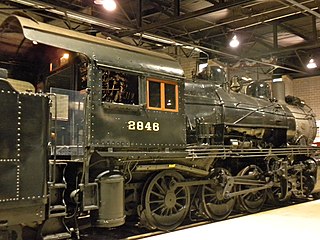
The Pennsylvania Railroad's class H6, H6a, and H6b steam locomotives were of the 2-8-0 "Consolidation" freight type, the most numerous class on the railroad with 2,032 units, and the second most prolific 2-8-0 class in North America, with the USATC S160 class rostering 88 units more. The three subclasses differed as follows:

The Russian locomotive class Ye, and subclasses Yea, Yek, Yel, Yef, Yem, Yemv and Yes were a series of 2-10-0 locomotives built by American builders for the Russian railways in World War I and again in World War II. They were lightweight engines with relatively low axle loadings.
The Queensland Railways AC16 class locomotive was a class of 2-8-2 steam locomotives operated by the Queensland Railways.
The China Railways KD23 class locomotive was a class of 2-8-0 steam locomotives operated by the China Railway. Originally amongst the first locomotives ordered by the South Manchuria Railway (Mantetsu), they were built by ALCo of the United States in 1906, and they were later operated by the privately owned Jichang Jidun Railway and its successor, the Manchukuo National Railway. The "Sori" name comes from the American naming system for steam locomotives, in which the 2-8-0 wheel arrangement is called "Consolidation".
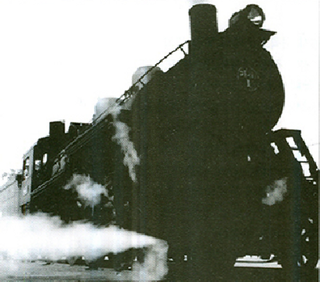
The Pashii class (パシイ) locomotives were a group of steam tender locomotives of the Chosen Government Railway (Sentetsu) with 4-6-2 wheel arrangement. The "Pashi" name came from the American naming system for steam locomotives, under which locomotives with 4-6-2 wheel arrangement were called "Pacific".

